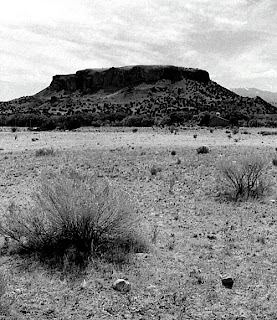Identities and boundaries. Tommy Lee Jones is a white man who has left his young family and gone native. He’s been taken into a tribe of the Chiricahua and grown old there. With his long hair, unsmiling stare, and ravaged face, he is far more convincing in the part than Paul Newman managed to be in Hombre.
Yet he hasn’t shaken his white identity. Returning as the father of the woman he once deserted when she was still a girl, he’s doing a kind of penance for crossing cultural boundaries at the expense of his family. Pursuing the Apaches who have stolen Blanchett’s daughter, he is making an Indian version of amends.
 |
| Latir Peak Wilderness, New Mexico, photo by Dave Herrera |
A chief of the Chiricahua joins the chase. Handsome and self-possessed, he is fluent in Spanish and communicates easily across the cultural divide with Blanchett. A doctor herself, she treats the chief’s son who has been stricken by a debilitating curse. Cursed herself by the evil Apache, she is brought back to health by Chiricahua medicine.
Finally, she even agrees to wear a bead necklace as a protective charm. Thus her own carefully defended identity is altered in a mutual crossing of cultural and racial boundaries. All well and good, we are given to understand.
 |
| Questa, New Mexico, 1943 |
When filmmakers do this, the choice is telling. Graphic violence goes for a gross-out shock effect, while the indirect portrayal of it can trigger our deepest, darkest fears. One numbs us after a while; the other stirs up a lingering sense of vulnerability with a more lasting effect. Howard went for gross-out shock, and for my money it misfires.
 |
| Black Mesa, New Mexico, photo by Steve Deger |
Blanchett’s character is an even match for him. She is tough and fearless, and while she comes to rely on him, she never yields to his authority. Yes, the girls are rescued and manage to escape, with the Apaches in hot pursuit.
But there’s not much sentiment between father and daughter by film’s end, only a brief scene while they wait with guns loaded for the final assault. In this convention of the modern western, she lets down her guard a bit and he opens up a bit. But then there is the last battle, and only one survives to escort the girls back to civilization.
The Missing is based on the novel Last Ride
Photo credits: Wikimedia Commons
Coming up: Oscar Micheaux, The Conquest (1913)

This is one of my favourite westerns of recent years. It's shown on TV here in the UK quite often, although it does get cut when shown in the afternoons.
ReplyDelete"The Missing" is in my top 10 flicks; kinda scared the tar out of me the first time and messed with the wife's head! Val Kilmer had a couple of minutes in there as well!
ReplyDeleteI've seen it, but on TV and they must have cut out a lot of the violence. I don't remember much of that. I enjoyed it though.
ReplyDeleteEpic
DeleteIt is a good flick. I watched this because of Howard's direction and to see what Eric Schweig was like. I am still surprised Schweig did not become a major heartthrob after LAST OF THE MOHICANS.
ReplyDeleteHaven't seen Missing, but I'll pick up a copy of the Last Ride when I see it. It sounds similar to the capture by the Mohaves (or Yavapai) of the Oatman girls in Arizona.
ReplyDeletehi, i'm travelling from razored zen. i enjoyed all the pictures of the deserts, they are beautiful. missing had been on tv but i had never really watched it from beginning to end. i will the next time it comes on.
ReplyDeleteThere is a lot in common here with Dorothy Johnson's A Man Called Horse, in which a frontier drifter is captured--and is turned into a man.
ReplyDelete